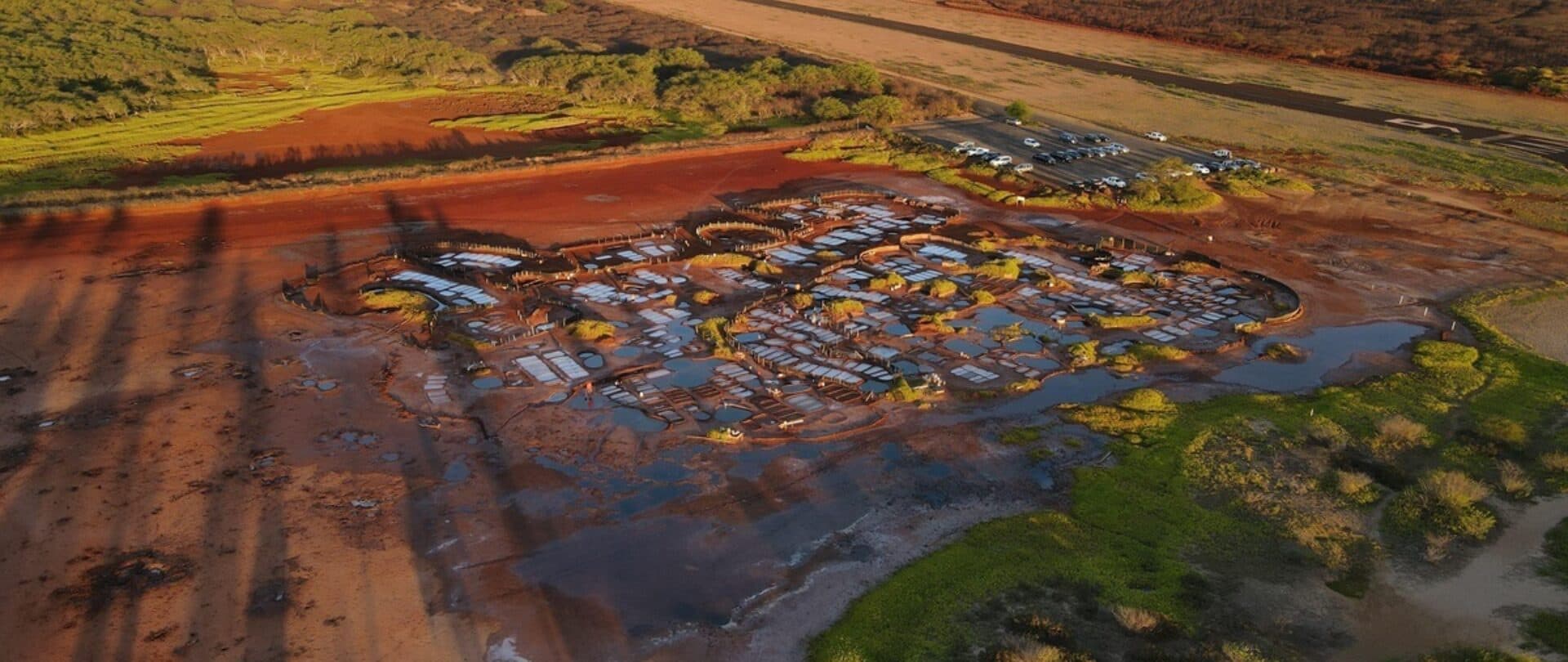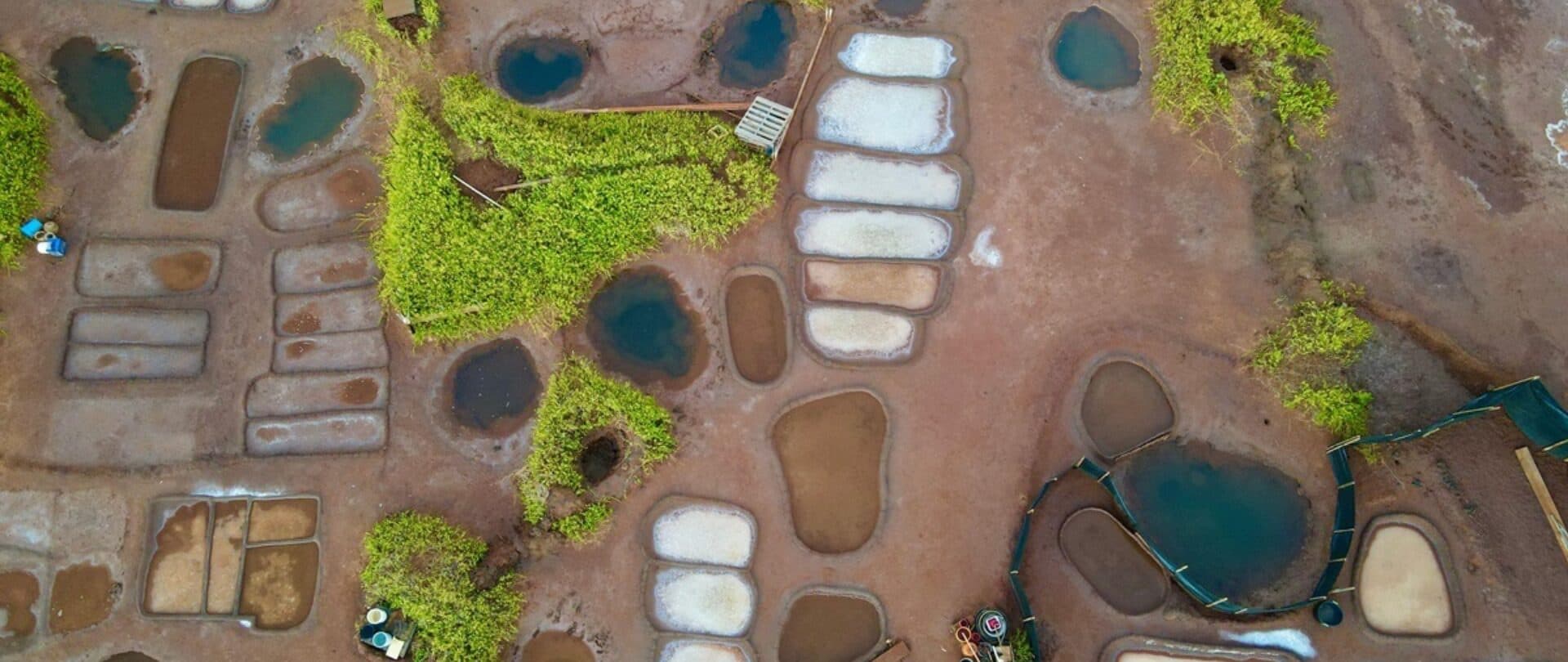Salt Makers
Pa‘akai: Holistic Salt from Hanapēpē Salt Pond
BY Mary Troy Johnston, Ph.D.
Exotic salt has become a fascinating trend: red, pink and black salt from Hawaiʻi, the Himalayas, the Guérande peninsula in France and the Atacama Desert in Chile. Yet, none is comparable to the salt made in Hanapēpē on the west shore of Kauaʻi. Salt-pond salt is made by salt makers informed by a practice that has endured for over a thousand years on Kaua’i, following in the well-trodden steps of their ancestors. The unique site is environmentally situated far enough from the ocean for the beds not to be flooded during the salt-making season (May through September) on a plain of mineral-rich red soil, close enough to the ocean to draw salt water from naturally flowing underground wells that connect to the pristine seawater. Pa‘akai, the Hawaiian word for salt, is also the word for a dedication to salt making for its spiritual and cultural purposes, a holistic dedication that approximately twenty-two Salt Pond families have accepted as their kuleana (responsibility, as in a higher calling) to caretake for future generations. Unsurprisingly, the meaning of pa‘akai also references a miracle we tend to take for granted: kai is the ocean that becomes pa‘a, which is hard. The Hawaiian language is skillful in the revelation in one word of a complicated process: seawater evaporated into salt with interconnected elements of water, sun and land.
Hawaiian lā‘au lapa‘au practitioner and healer Sean Chun elaborated on the spiritual and healing attributes of pa‘akai. When pa‘akai is “cleansed of lepo (dirt) and added to fresh water, it becomes Waikapu a Kāne, the sacred water of K ā ne,” according to Sean. K ā ne was the leading Hawaiian deity, the god of creation and the giver of life. Sean recalls the powerful “ritualistic blessing called pīkai (sprinkling of salt water) to cleanse a person of evil influences.” From the beginning, Hawaiians have looked to pa‘akai to remove evil presences from their persons, to purify their homes or as a cleansing ritual after a funeral. The practice carries over when a person puts a bit of salt on the tongue to guard against evil.
When pa‘akai is mixed with water, it becomes wai pa‘akai (salt water). ‘Alaea (Hawaiian sea salt mixed with volcanic clay called ‘alaea, a brick-red colored clay) may also be added. This form enhances the healing properties of pa‘akai. Sean outlines several healing effects. The solution is “consumed to clean out a person’s bowels as part of the protocol for treating people internally with la‘au lapa‘au (traditional Hawaiian medicine).” It is also used as a gargle “to clean cold sores or treat a sore throat.” When pa‘akai is combined with herbs and pounded into a poultice, “the pa‘akai is anti-bacterial and draws out the vital phytochemicals in plants to treat external injuries, aches or wounds.”
Ancient Hawaiians did not need a scientific analysis of the value of island salt. We know Hawaiian salt's nutritional benefits, especially when mixed with algae. It is chockful of natural nutrients and is especially noted for being mineral-rich, such as magnesium and potassium, which are required for bone health and beneficial for heart functioning. As our bodies do not make these minerals, eating food containing them is important. This salt also contains relatively less sodium chloride than most salts, sodium being the element that can tamper with blood pressure. Another positive feature is the iron found in the ‘alaea, which is more digestible than other sources. In Hawai‘i, the material value of pa‘akai manifested in the sacred attachment to the salt. Throughout Hawaiian history, salt has been used in blessings, cleansing homes and temples, and many rituals, for instance, sending off canoes to bring good luck on a voyage and couples to be wedded dipping their hands in saltwater to prepare for their journey. Hawaiian salt is believed to enhance mana (spiritual power). When salt makers from Hanapēpē sent salt to their kindred who survived the Maui fires, the gesture sent a powerful message of cleansing, healing, sacred blessing and mana for recovery.
The labor required to prepare the beds, dip briny salt water out of the wai kū (holding tanks for the seawater that flows through underground wells), fill the ponds and harvest the salt is hard work. It is a family affair, first, because of the devotion passed down through generations and the desire to preserve a tradition. It is a way of connecting with ancestors, keeping alive the ways things were done, and teaching this to keiki (children) who learn by watching and doing. The work at Salt Pond is intensive and requires many hands of multiple generations who come together to farm pa‘akai. Ku‘uleialoha Gaisoa, whose father was in the salt patch for eighty or more years and she for over forty-five, shares the tradition. She describes how the keiki love to make clay balls, but the clay is getting harder to find. The adults reshape the balls with a lava rock to line the beds. She makes no bones about the demands of the work. It is hard work and performed as a labor of love. Times have certainly changed, and new situations have yielded new practices. Nonetheless, so much remains the same. She asks, “Do we get down on our hands and knees and rub our beds with a rough rock and a smooth rock? Is that the same technique? YES IT IS.” She continues, “Do you hunt for black clay to make these beds? I don’t know if, back in the day, they had to hunt as much as we do.” Admittedly, today’s tools include “a shovel and a wheelbarrow,” but the work is still largely left up to the people. It is not mechanized as it is elsewhere in the world. According to Ku‘uleialoha, “Some of us rub beds all day.”
The work is not dreaded, though. It is very familiar, almost innate, and fulfilling. Ku‘uleialoha summarizes how the work is necessary to the mission. She relates, “Salt workers were raised to work. To walk into the patch, give a little nod to the people around and work. There is a job to be done: to create Hawaiian salt to share, give and support the people.” The tradition is to gift the salt or to barter, but it is not sold. she concludes that the mission is something “we all understand”. Nothing distracts her from her goal. She describes the ultimately rewarding experience, “Salt Pond is my favorite place to be, and I make sure I do everything I can to help to protect and preserve.”
If preserving Salt Pond only required the devotion and enduring efforts of Ku‘uleialoha and other salt makers, the future would be guaranteed. Sadly, the environment that nests the salt beds has undergone dramatic change, creating a real sense of urgency about whether the ponds will continue to produce into the future and whether this last tradition of farming salt in keeping with ancient practice will survive.
The tidal and wave patterns have changed with climate change. The beds must be relatively dry from May until September to evaporate the saltwater in the ponds. The handmade beds are deep enough to hold water but shallow enough to permit evaporation from the sun. An overflow of the beds or a breach caused by groundwater can disrupt the natural process. Climate change has precipitated floods from higher tides, not to mention more extreme wave action, also causing coastal erosion, making conditions more unpredictable. The continuation of this ancient practice depends on environmental conditions replicating those of the past. A requisite is that the beds must be able to have a boundary from encroaching water during the salt-making season. Furthermore, natural resources, such as brine shrimp that flavor the salt and pure water, must be in good supply but are subject to change. Pollutants have become a significant concern, whether from the reckless discard of items, leaching cesspools or feces from feral animals. All of these are growing problems on Kaua‘i. There are too many environmental threats to list, but the situation is dire for natural resources. Last season’s salt production was dismal; in some ponds, salt makers had nothing to show for their efforts, whereas, in generations past, vast mounds of crystallized salt would demonstrate their extraordinary labor. Sadly, there is not a lot of salt to be shared.
Pa‘akai is a holistic substance. It has a material value that has long enhanced the cuisine of Hawai‘i: poke and lomi lomi (salted salmon mixture) and pipikaula (beef rope like a jerky product). In old Hawai‘i, salt was essential in preserving abundant fish to prevent spoilage. The salmon from the Pacific Northwest, which became a favorite of the Hawaiian laborers who entered the fur trade, could only be transported back to Hawai‘i packed in salt. The cultural value of pa‘akai is all the greater. The cultivation of salt mirrors ancient Hawaiians' relationship to the sea and the land, realizing the knowledge and care they must have for resources that sustained them. It is the medium through which ancestors transmit their knowledge, healers continue the practice of traditional medicine and the people of Kaua‘i experience the sacred. The loss of pa‘akai would be holistic, taking a toll far beyond Salt Pond. It’s no wonder Ku‘uleialoha when asked the title she wanted to use for this article, replied, “Salt maker.” No other title could so distinguish her life’s work.




